Jiabao Wang
COME: Adding Scene-Centric Forecasting Control to Occupancy World Model
Jun 16, 2025Abstract:World models are critical for autonomous driving to simulate environmental dynamics and generate synthetic data. Existing methods struggle to disentangle ego-vehicle motion (perspective shifts) from scene evolvement (agent interactions), leading to suboptimal predictions. Instead, we propose to separate environmental changes from ego-motion by leveraging the scene-centric coordinate systems. In this paper, we introduce COME: a framework that integrates scene-centric forecasting Control into the Occupancy world ModEl. Specifically, COME first generates ego-irrelevant, spatially consistent future features through a scene-centric prediction branch, which are then converted into scene condition using a tailored ControlNet. These condition features are subsequently injected into the occupancy world model, enabling more accurate and controllable future occupancy predictions. Experimental results on the nuScenes-Occ3D dataset show that COME achieves consistent and significant improvements over state-of-the-art (SOTA) methods across diverse configurations, including different input sources (ground-truth, camera-based, fusion-based occupancy) and prediction horizons (3s and 8s). For example, under the same settings, COME achieves 26.3% better mIoU metric than DOME and 23.7% better mIoU metric than UniScene. These results highlight the efficacy of disentangled representation learning in enhancing spatio-temporal prediction fidelity for world models. Code and videos will be available at https://github.com/synsin0/COME.
HUGSIM: A Real-Time, Photo-Realistic and Closed-Loop Simulator for Autonomous Driving
Dec 02, 2024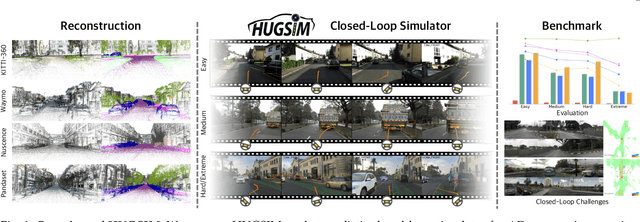

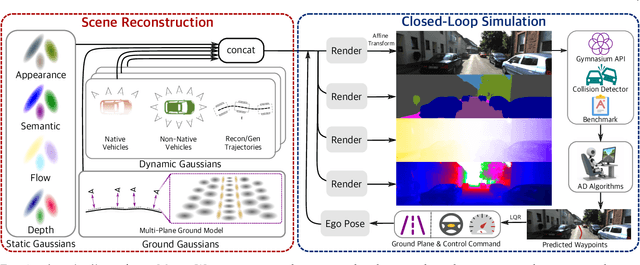

Abstract:In the past few decades, autonomous driving algorithms have made significant progress in perception, planning, and control. However, evaluating individual components does not fully reflect the performance of entire systems, highlighting the need for more holistic assessment methods. This motivates the development of HUGSIM, a closed-loop, photo-realistic, and real-time simulator for evaluating autonomous driving algorithms. We achieve this by lifting captured 2D RGB images into the 3D space via 3D Gaussian Splatting, improving the rendering quality for closed-loop scenarios, and building the closed-loop environment. In terms of rendering, We tackle challenges of novel view synthesis in closed-loop scenarios, including viewpoint extrapolation and 360-degree vehicle rendering. Beyond novel view synthesis, HUGSIM further enables the full closed simulation loop, dynamically updating the ego and actor states and observations based on control commands. Moreover, HUGSIM offers a comprehensive benchmark across more than 70 sequences from KITTI-360, Waymo, nuScenes, and PandaSet, along with over 400 varying scenarios, providing a fair and realistic evaluation platform for existing autonomous driving algorithms. HUGSIM not only serves as an intuitive evaluation benchmark but also unlocks the potential for fine-tuning autonomous driving algorithms in a photorealistic closed-loop setting.
Vision Mamba Distillation for Low-resolution Fine-grained Image Classification
Nov 27, 2024



Abstract:Low-resolution fine-grained image classification has recently made significant progress, largely thanks to the super-resolution techniques and knowledge distillation methods. However, these approaches lead to an exponential increase in the number of parameters and computational complexity of models. In order to solve this problem, in this letter, we propose a Vision Mamba Distillation (ViMD) approach to enhance the effectiveness and efficiency of low-resolution fine-grained image classification. Concretely, a lightweight super-resolution vision Mamba classification network (SRVM-Net) is proposed to improve its capability for extracting visual features by redesigning the classification sub-network with Mamba modeling. Moreover, we design a novel multi-level Mamba knowledge distillation loss boosting the performance, which can transfer prior knowledge obtained from a High-resolution Vision Mamba classification Network (HRVM-Net) as a teacher into the proposed SRVM-Net as a student. Extensive experiments on seven public fine-grained classification datasets related to benchmarks confirm our ViMD achieves a new state-of-the-art performance. While having higher accuracy, ViMD outperforms similar methods with fewer parameters and FLOPs, which is more suitable for embedded device applications. Code is available at https://github.com/boa2004plaust/ViMD.
Paying more attention to local contrast: improving infrared small target detection performance via prior knowledge
Nov 20, 2024Abstract:The data-driven method for infrared small target detection (IRSTD) has achieved promising results. However, due to the small scale of infrared small target datasets and the limited number of pixels occupied by the targets themselves, it is a challenging task for deep learning methods to directly learn from these samples. Utilizing human expert knowledge to assist deep learning methods in better learning is worthy of exploration. To effectively guide the model to focus on targets' spatial features, this paper proposes the Local Contrast Attention Enhanced infrared small target detection Network (LCAE-Net), combining prior knowledge with data-driven deep learning methods. LCAE-Net is a U-shaped neural network model which consists of two developed modules: a Local Contrast Enhancement (LCE) module and a Channel Attention Enhancement (CAE) module. The LCE module takes advantages of prior knowledge, leveraging handcrafted convolution operator to acquire Local Contrast Attention (LCA), which could realize background suppression while enhance the potential target region, thus guiding the neural network to pay more attention to potential infrared small targets' location information. To effectively utilize the response information throughout downsampling progresses, the CAE module is proposed to achieve the information fusion among feature maps' different channels. Experimental results indicate that our LCAE-Net outperforms existing state-of-the-art methods on the three public datasets NUDT-SIRST, NUAA-SIRST, and IRSTD-1K, and its detection speed could reach up to 70 fps. Meanwhile, our model has a parameter count and Floating-Point Operations (FLOPs) of 1.945M and 4.862G respectively, which is suitable for deployment on edge devices.
Guided Self-attention: Find the Generalized Necessarily Distinct Vectors for Grain Size Grading
Oct 08, 2024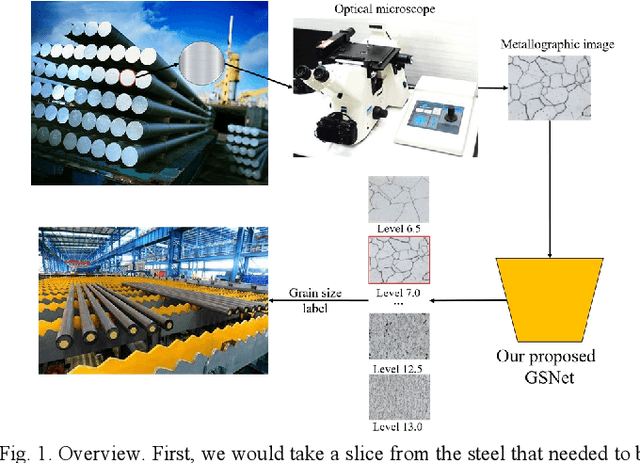

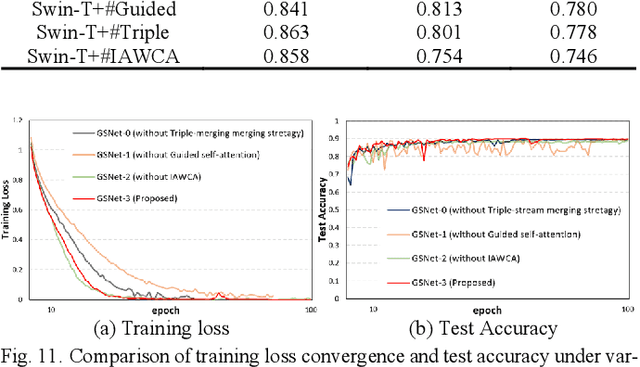

Abstract:With the development of steel materials, metallographic analysis has become increasingly important. Unfortunately, grain size analysis is a manual process that requires experts to evaluate metallographic photographs, which is unreliable and time-consuming. To resolve this problem, we propose a novel classifi-cation method based on deep learning, namely GSNets, a family of hybrid models which can effectively introduce guided self-attention for classifying grain size. Concretely, we build our models from three insights:(1) Introducing our novel guided self-attention module can assist the model in finding the generalized necessarily distinct vectors capable of retaining intricate rela-tional connections and rich local feature information; (2) By improving the pixel-wise linear independence of the feature map, the highly condensed semantic representation will be captured by the model; (3) Our novel triple-stream merging module can significantly improve the generalization capability and efficiency of the model. Experiments show that our GSNet yields a classifi-cation accuracy of 90.1%, surpassing the state-of-the-art Swin Transformer V2 by 1.9% on the steel grain size dataset, which comprises 3,599 images with 14 grain size levels. Furthermore, we intuitively believe our approach is applicable to broader ap-plications like object detection and semantic segmentation.
OPUS: Occupancy Prediction Using a Sparse Set
Sep 14, 2024
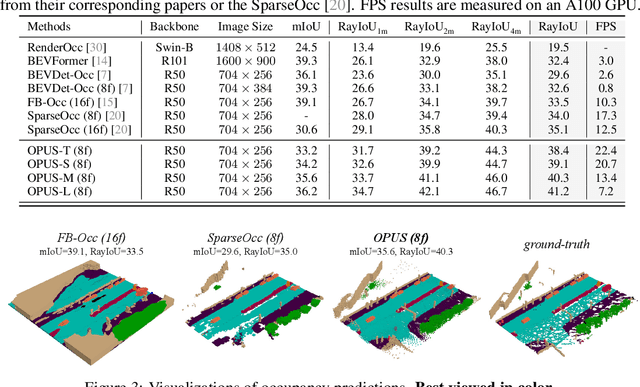
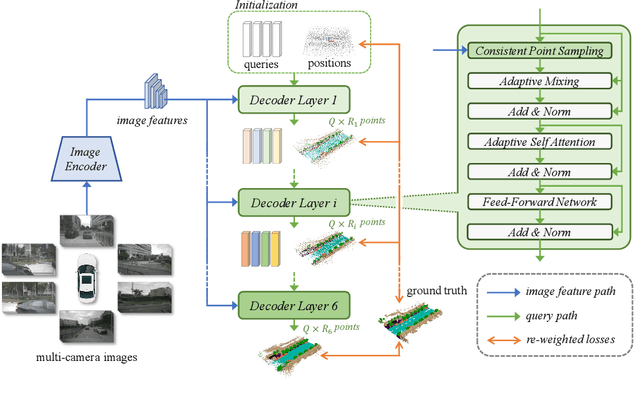
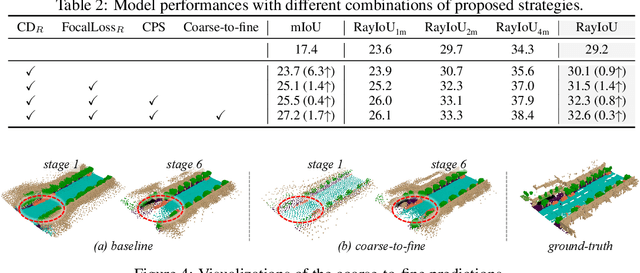
Abstract:Occupancy prediction, aiming at predicting the occupancy status within voxelized 3D environment, is quickly gaining momentum within the autonomous driving community. Mainstream occupancy prediction works first discretize the 3D environment into voxels, then perform classification on such dense grids. However, inspection on sample data reveals that the vast majority of voxels is unoccupied. Performing classification on these empty voxels demands suboptimal computation resource allocation, and reducing such empty voxels necessitates complex algorithm designs. To this end, we present a novel perspective on the occupancy prediction task: formulating it as a streamlined set prediction paradigm without the need for explicit space modeling or complex sparsification procedures. Our proposed framework, called OPUS, utilizes a transformer encoder-decoder architecture to simultaneously predict occupied locations and classes using a set of learnable queries. Firstly, we employ the Chamfer distance loss to scale the set-to-set comparison problem to unprecedented magnitudes, making training such model end-to-end a reality. Subsequently, semantic classes are adaptively assigned using nearest neighbor search based on the learned locations. In addition, OPUS incorporates a suite of non-trivial strategies to enhance model performance, including coarse-to-fine learning, consistent point sampling, and adaptive re-weighting, etc. Finally, compared with current state-of-the-art methods, our lightest model achieves superior RayIoU on the Occ3D-nuScenes dataset at near 2x FPS, while our heaviest model surpasses previous best results by 6.1 RayIoU.
Towards Stable 3D Object Detection
Jul 05, 2024



Abstract:In autonomous driving, the temporal stability of 3D object detection greatly impacts the driving safety. However, the detection stability cannot be accessed by existing metrics such as mAP and MOTA, and consequently is less explored by the community. To bridge this gap, this work proposes Stability Index (SI), a new metric that can comprehensively evaluate the stability of 3D detectors in terms of confidence, box localization, extent, and heading. By benchmarking state-of-the-art object detectors on the Waymo Open Dataset, SI reveals interesting properties of object stability that have not been previously discovered by other metrics. To help models improve their stability, we further introduce a general and effective training strategy, called Prediction Consistency Learning (PCL). PCL essentially encourages the prediction consistency of the same objects under different timestamps and augmentations, leading to enhanced detection stability. Furthermore, we examine the effectiveness of PCL with the widely-used CenterPoint, and achieve a remarkable SI of 86.00 for vehicle class, surpassing the baseline by 5.48. We hope our work could serve as a reliable baseline and draw the community's attention to this crucial issue in 3D object detection. Codes will be made publicly available.
HAAP: Vision-context Hierarchical Attention Autoregressive with Adaptive Permutation for Scene Text Recognition
May 15, 2024Abstract:Internal Language Model (LM)-based methods use permutation language modeling (PLM) to solve the error correction caused by conditional independence in external LM-based methods. However, random permutations of human interference cause fit oscillations in the model training, and Iterative Refinement (IR) operation to improve multimodal information decoupling also introduces additional overhead. To address these issues, this paper proposes the Hierarchical Attention autoregressive Model with Adaptive Permutation (HAAP) to enhance the location-context-image interaction capability, improving autoregressive generalization with internal LM. First, we propose Implicit Permutation Neurons (IPN) to generate adaptive attention masks to dynamically exploit token dependencies. The adaptive masks increase the diversity of training data and prevent model dependency on a specific order. It reduces the training overhead of PLM while avoiding training fit oscillations. Second, we develop Cross-modal Hierarchical Attention mechanism (CHA) to couple context and image features. This processing establishes rich positional semantic dependencies between context and image while avoiding IR. Extensive experimental results show the proposed HAAP achieves state-of-the-art (SOTA) performance in terms of accuracy, complexity, and latency on several datasets.
Align-Free Multi-Plane Phase Retrieval
Apr 30, 2024Abstract:The multi-plane phase retrieval method provides a budget-friendly and effective way to perform phase imaging, yet it often encounters alignment challenges due to shifts along the optical axis in experiments. Traditional methods, such as employing beamsplitters instead of mechanical stage movements or adjusting focus using tunable light sources, add complexity to the setup required for multi-plane phase retrieval. Attempts to address these issues computationally face difficulties due to the variable impact of diffraction, which renders conventional homography techniques inadequate. In our research, we introduce a novel Adaptive Cascade Calibrated (ACC) strategy for multi-plane phase retrieval that overcomes misalignment issues. This technique detects feature points within the refocused sample space and calculates the transformation matrix for neighboring planes on-the-fly to digitally adjust measurements, facilitating alignment-free multi-plane phase retrieval. This approach not only avoids the need for complex and expensive optical hardware but also simplifies the imaging setup, reducing overall costs. The effectiveness of our method is validated through simulations and real-world optical experiments.
The Third Monocular Depth Estimation Challenge
Apr 27, 2024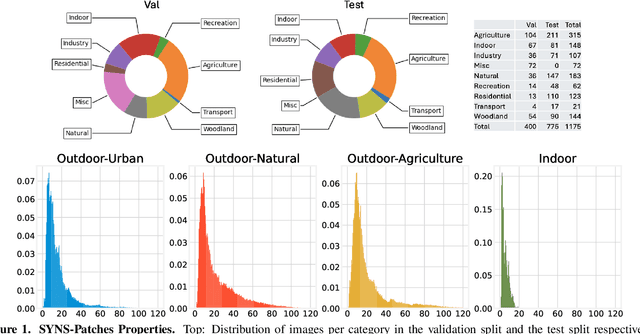


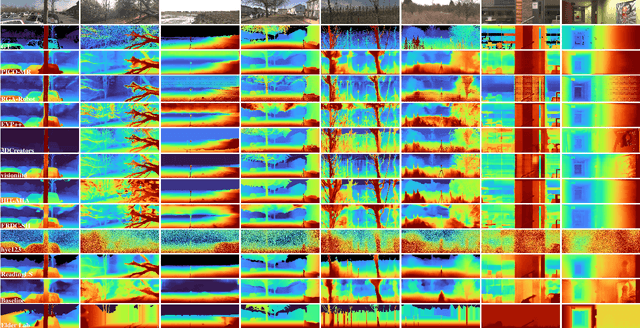
Abstract:This paper discusses the results of the third edition of the Monocular Depth Estimation Challenge (MDEC). The challenge focuses on zero-shot generalization to the challenging SYNS-Patches dataset, featuring complex scenes in natural and indoor settings. As with the previous edition, methods can use any form of supervision, i.e. supervised or self-supervised. The challenge received a total of 19 submissions outperforming the baseline on the test set: 10 among them submitted a report describing their approach, highlighting a diffused use of foundational models such as Depth Anything at the core of their method. The challenge winners drastically improved 3D F-Score performance, from 17.51% to 23.72%.
 Add to Chrome
Add to Chrome Add to Firefox
Add to Firefox Add to Edge
Add to Edge